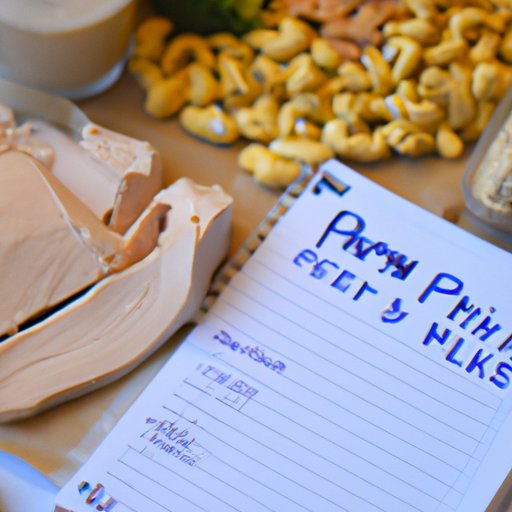Introduction
A high-protein diet is one that emphasizes the consumption of protein-rich foods such as lean meats, eggs, fish, legumes, nuts, and seeds. This type of diet has become increasingly popular in recent years due to its many potential health benefits, including aiding weight loss, building muscle mass, and improving overall health. But what percentage of diet should be protein? In this article, we’ll explore the recommended amount of protein to include in your diet, the health benefits of eating a high-protein diet, and meal planning tips for maximizing your protein intake.
What Should Your Protein Intake Be?
The recommended daily allowance (RDA) for protein is 0.8 grams per kilogram of body weight for adults. However, if you are trying to lose weight or build muscle, your protein needs may be higher than the RDA. To calculate the right amount of protein for your diet, multiply your weight in pounds by 0.36 to get your recommended daily protein intake.
For example, if you weigh 150 pounds, your recommended daily protein intake would be 54 grams per day. If you are trying to build muscle, you may want to increase your protein intake to 1.2 to 1.7 grams per kilogram of body weight. For someone who weighs 150 pounds, that would mean an increase of 81 to 114 grams of protein per day.

Exploring the Benefits of Protein in Your Diet
Eating a high-protein diet has numerous health benefits, from promoting weight loss to reducing the risk of certain diseases. Here are some of the key benefits of incorporating more protein into your diet:
Health Benefits of Eating a High-Protein Diet
Eating a high-protein diet can help reduce the risk of certain chronic diseases, such as heart disease and type 2 diabetes. It can also help lower cholesterol levels and blood pressure. Additionally, studies have found that high-protein diets can help improve bone health, reduce inflammation, and boost immunity.
Weight Loss Benefits of Eating a High-Protein Diet
High-protein diets can also help with weight loss. Protein is more filling than other macronutrients, so adding more protein to your meals can help you feel fuller for longer and reduce hunger cravings. Protein can also help preserve muscle mass during weight loss, which helps you maintain a healthy metabolism. Additionally, protein takes more energy to digest than other macronutrients, so it can help boost your calorie burn.

Meal Planning Tips for Maximizing Protein Intake
Incorporating more protein into your diet doesn’t have to be difficult. Here are some tips for making sure you’re getting enough protein in your meals:
Tips for Incorporating More Protein Into Your Meals
- Make protein the centerpiece of each meal. Aim to make at least 25-30% of your plate protein-rich foods.
- Opt for lean proteins like poultry, fish, and seafood.
- Include protein-rich snacks throughout the day, such as nuts, seeds, yogurt, or hard-boiled eggs.
- Choose plant-based proteins like beans, lentils, and tofu.
- Add protein powder to smoothies, oatmeal, and baked goods.
High-Protein Foods to Include in Your Diet
- Eggs
- Greek yogurt
- Chicken breast
- Lean beef
- Quinoa
- Almonds
- Chickpeas
- Tofu
- Lentils
- Edamame
A Guide to Incorporating More Protein Into Your Diet
If you’re looking to incorporate more protein into your diet, there are several strategies you can use to make sure you’re getting enough. Here are some tips for increasing your protein intake:
Strategies for Increasing Protein Intake
- Eat a protein-rich breakfast. Start your day off with a breakfast that includes at least 20-25 grams of protein, such as eggs, Greek yogurt, or overnight oats.
- Snack on protein-rich foods. Instead of reaching for sugary snacks, opt for protein-packed options like nuts, seeds, or hard-boiled eggs.
- Add protein powder to shakes and smoothies. Protein powders are an easy way to add extra protein to your meals and snacks.
- Swap out carbs for protein. Instead of loading up on carbohydrates, choose a protein-rich food instead, such as quinoa, lentils, or edamame.
- Make substitutions in recipes. Swap out high-carb ingredients like pasta, rice, and potatoes for protein-rich alternatives, such as tofu, tempeh, or chickpeas.
Best Sources of Plant-Based Protein
- Legumes (beans, peas, lentils)
- Nuts and nut butters
- Seeds and seed butters
- Whole grains (quinoa, oats, buckwheat)
- Tofu, tempeh, and edamame
- Hemp hearts
- Green peas
- Soy milk
Conclusion
Protein is an essential part of any healthy diet, and eating a high-protein diet can offer numerous health and weight loss benefits. While the recommended daily allowance for protein is 0.8 grams per kilogram of body weight, those looking to build muscle or lose weight may need to increase their protein intake. There are many ways to incorporate more protein into your diet, such as swapping out carbs for protein-rich foods, snacking on protein-packed snacks, and adding protein powder to shakes and smoothies. When it comes to finding the right balance of protein in your diet, it’s important to listen to your body and adjust your protein intake accordingly.
(Note: Is this article not meeting your expectations? Do you have knowledge or insights to share? Unlock new opportunities and expand your reach by joining our authors team. Click Registration to join us and share your expertise with our readers.)
